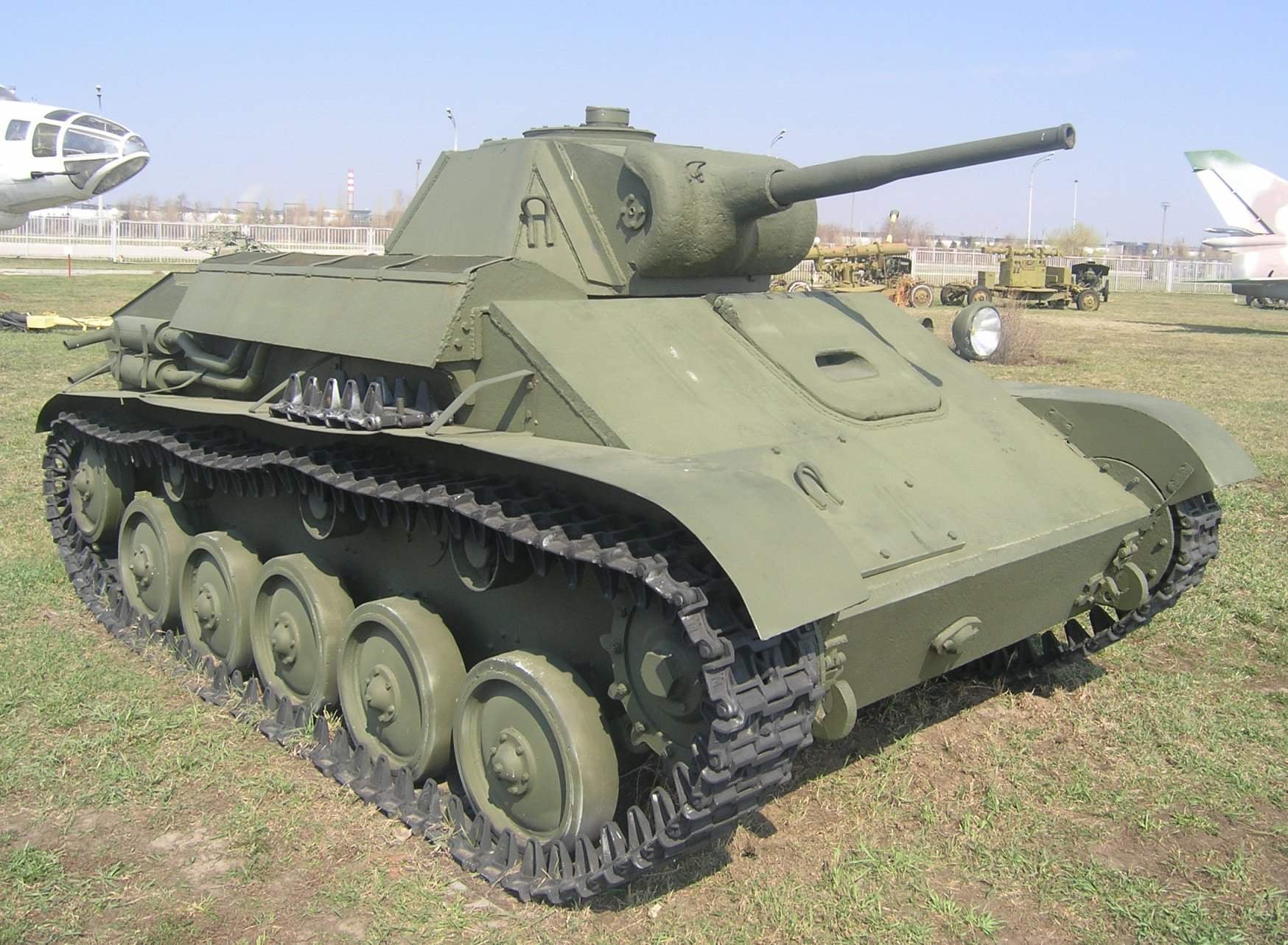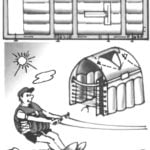 In October 1941, it became clear that the new light tank T-60, serial production of which began earlier this month, almost useless on the battlefield, His armor freely fought all anti-tank weapons of the Wehrmacht, and his own arms were too weak to fight with tanks of the enemy. To strengthen the same and then another without major design changes are not possible, the Engine and gearbox had worked in the overdriven mode. Growth of same weight combat vehicle, inevitable in the amplification of booking and weapons just would lead to the release of these units from the building Required a different solution.
In October 1941, it became clear that the new light tank T-60, serial production of which began earlier this month, almost useless on the battlefield, His armor freely fought all anti-tank weapons of the Wehrmacht, and his own arms were too weak to fight with tanks of the enemy. To strengthen the same and then another without major design changes are not possible, the Engine and gearbox had worked in the overdriven mode. Growth of same weight combat vehicle, inevitable in the amplification of booking and weapons just would lead to the release of these units from the building Required a different solution.
In September 1941 the Bureau of plant No. 37, at that time head of the production of the T-60, offered a variant of its modernization, which received the designation T-45. In fact, it was the same T-60, but with the new tower, which was installed 45-mm gun. This machine was supposed to use a new engine ZIS-60 rated at 100 HP, which would increase the thickness of the frontal armor of the tank to 35 — 45 mm. However, to master the production of engine plant ZIS could not in connection with the evacuation from Moscow to the Urals, in Miass. Not saved position and try to install on the tank engine ZIS-16 with a capacity of 86 HP With its spending also, not all went smoothly, and time was critical.
In parallel with the factory # 37 work on the creation of a new light tank was developed at the Gorky automobile plant. In this scenario, there was nothing unusual — the company had already had experience of production of armored vehicles, engaging in serial production tankettes T-27 and small amphibious tank T-37A in the 1930-ies there were also designed and manufactured a number of prototypes of armored vehicles In September 1941 the plant received the task of mass production of light tank T-60, for which the Gas was made a separate structural unit of tank production and the corresponding CB At the beginning of September, the chief designer of plant No. 37 N. And two days later overtook his way from Moscow to Gorky prototype of the T-60, which was to be used on Gas as a reference. N..Aster was also left on the Gas to aid in the organization of production tanks.
That is when I was introduced to the red Army GABTU a draft of a new light tank with reinforced armor and weapons, created based on the T-60.
As the power plant on this machine was supposed to use a spark automotive engines GAZ-202. Prototypes of the coupled power units received index GAZ-203, were manufactured by the end of November. However, when the first two trials using 6 — 10 hours of work began to break down crank shafts of the second motors, and only thanks to the efforts of designers under the guidance of A. A. Lipgart resource coupled to the power unit managed to bring to the required 100 hours. Designing a new tank in KB Gas began in late October 1941. It was conducted very quickly, with the use adopted in the automotive industry reception, unusual for tank designers. Common types of combat vehicles were drawn from a special aluminum plates with dimensions 7×3 m, white painted, and divided into squares with dimensions of 200×200 mm. To reduce the drawing area and increase the accuracy on the main view — longitudinal section — were imposed plan, as well as total and partial cross sections. The drawings were made as detailed as possible and included all the components and details of internal and external equipment of the machine. These drawings later served as the basis for control in the Assembly of the prototype and even the entire first series of machines.


Light tank T-70M:
1 — driving wheel, 2 — 45 mm gun, 3 — gun DT, 4 — observation instrument MK-4, 5 — plug for firing of personal weapons. 6 — supporting the ice rink, 7 — guide wheel, 8 — track roller, 9 — hatch access to powertrain, 10 — reservation Luke air flow units, 11 — hatch over the filling hole cooling system, 12 — louver vozdukhovody, 13 spare reference skiff, 14 — manhole covers over water-fuel cap, 15 — hatch of the commander, 16 mufflers, 17 — manhole cover to install a portable blowtorch to start the engine in winter, 18 light, 19 cover of the driver’s hatch, 20 — access hole for manual start engines, 21 — cover of the hatch of the emergency exit 22 — towing device
At the end of December 1941 for the tank, which received the factory designation GAZ-70, welded hull and cast turret, designed by V. Dedkova. Along with a cast of developed and version welded turret. The Assembly of the tank began in January of 1942 and for several reasons has been relatively slow. To complete it was only on 14 February, after which the tank was sent to Moscow, where he was shown to the representatives GABTU. The military new car much enthusiasm did not call. The armor tank is only slightly superior to the T-60, and nominally increased, thanks to the installation of the 45 mm gun, power weapons leveled the placement in the tower of one man, master of all trades — commander, gunner and loader. However, the N. A. Astrov promised in the shortest possible time to eliminate defects quickly managed to build up armor, increasing the thickness of lower frontal hull to 45 mm, and the top — up to 35 mm In total GKO decree of March 6, 1942, a new fighting vehicle was adopted for service with the red army under the T-70 two days Later saw the light and the GKO on the production of the tank, which according to its release in the month of April brought factories No. 37 and No. 38. However, the reality has not allowed these plans to be implemented fully, for example, the new tank required twice the engine than the T-60 has failed to establish production of cast towers, and Gas had hastily to provide other plants documentation on the welded tower. In the end, in April a plan to release a T-70 fulfilled only GAS that brought together 50 cars. Factory No. 38 in Kirov has managed to make only seven tanks, and the factory No. 37 Assembly failed to establish neither April nor in the future Layout of the new machine was no different from that of the T-60 driver-Mechanic was located in the bow of the hull at the left side In a rotating turret, also shifted to the left side, was a tank commander In the middle of the hull along the starboard side on a common frame were installed in series two engine, make a single power unit. Transmission and the drive wheels located in front.
Housing tank welded from rolled armor plates with a thickness of 45 mm. 6,10,15,25,35 and the welds were reinforced by riveting. Frontal and stern hull plates had a rational angles. At the top front of the compartment were the driver’s hatch, the cover of which the tanks of the first releases had peephole with a triplex, and then installed a rotary periscope observation device.
Welded faceted tower, being made of armor plates with a thickness of 35 mm, was mounted on a ball support in the middle of the hull and had the shape of a truncated pyramid Welded joints of the walls of the tower have been reinforced with armored corners of the Frontal portion had cast a mask with slits for the installation of cannon, machine gun and sight. In the roof of the tower did hatch of the tank commander In the armored hatch mounted periscope mirror device, provide the commander all-round visibility in addition, in the lid there was a hatch for flag signaling.

The tank T-70 was installed 45-mm tank gun OBR 1938 and left — a coaxial machine gun DT. For the convenience of the tank commander’s gun shifted to the right from the longitudinal axis of the tower. The length of the gun barrel was 46 calibers, the height of the line of fire — 1540 mm Angles pickup paired vertical setup ranged from -6° to +20°. For shooting used a telescopic sight TMFP (on some of the tanks were installed sight TOP) and mechanical as a backup. Sighting range was 3600 m, the maximum — 4800 m. When using the mechanical sight was possible only direct fire at a distance not more than 1000 m. firing guns — 12 rounds per minute, gear-turning mechanism of the tower was mounted to the left of the commander, and screw lifting mechanism coupled setup on the right. The trigger mechanism of the gun was a foot, descent gun was carried out by pressing the right pedal, and the machine gun on the left. The ammunition consisted of 90 rounds with armor-piercing and fragmentation shells for cannons (20 shots were in the store) and 945 rounds of machine gun DT (15 disks). The initial velocity armor-piercing projectile with a mass of 1.42 kg was 760 m/s, fragmental mass of 2.13 kg 335 m/s After the production of armor-piercing shot shell casing ejected automatically. When firing fragmentation shells due to shorter length of the cannon rolled back opening the breech and ejecting the casings was done manually. Powerplant GAZ-203 (70-6000) consisted of two four-stroke 6-cylinder gasoline engines GAZ-202 (GAZ 70-6004 front and GAS 70-6005 — back) total power 140 HP Crank shafts of the engines were connected together by a coupler with elastic sleeves. Flywheel housing front engine to prevent transverse vibrations of the power unit connected with a thrust to starboard. Battery ignition system, lubrication system and fuel (except tanks) system for each engine was independent. Two fuel tanks with a total capacity of 440 l were in the left part of the aft compartment of the housing in insulated armoured bulkheads of the compartment.
The drivetrain consisted of policetrainer double-disc main clutch dry friction (steel on ferrodo), four-speed transmission automobile type (4+1), main gear with conical reducer, two of steering clutches with band brakes and two simple, single-row final drives. The main clutch and transmission were assembled of parts borrowed from the truck ZIS-5.
Part of the propulsion tank in relation to the same Board was part of the drive wheel with removable gear cycloid gear, five single rubber-coated rollers and three metal rollers, guide wheel of the crank mechanism of a tension of a caterpillar and the caterpillar melkosofta of the 91 truck. The design of the idler and carrier roller has been standardized Width cast truck caterpillar was 260 mm. Suspension — personal torsion. Command tanks were equipped with a radio or 9P 12РТ placed in the tower, and an internal intercom system TPU-2F. For linear tanks were set lighting device for communication between a commander and driver-mechanic and the internal intercom TPU-2.
During the production of the mass of the tank increased from 9.2 to 9.8 t, and cruising on highway was decreased from 360 to 320 km.
In early October 1942 the GAS, and November and the plant No. 38 switched to production of tanks T-70M with an improved suspension. Width was increased (from 260 to 300 mm), and pitch tracks, the width of the rollers, and the diameter of the torsion bars (from 33.5 to 36 mm) suspension and gear rims of the drive wheels. The number of tracks in the track was reduced from 91 to 80 pieces only, in addition, were reinforced rollers, a stopping brake and final drives. The mass of the tank increased to 10 tons, and cruising on the highway dropped to 250 m. the gun Ammunition was reduced to 70 rounds.
Since the end of December 1942, the plant number 38 ceased production of tanks and switched to producing self-propelled guns SU-76 as a result, starting in 1943, light tanks for the red Army produced only Gas. In the second half of 1943, the release was accompanied by great difficulties From 5 to 14 June, the plant has undergone the German air raids. In Avtozavodskiy district, Gorky was thrown 2170 bombs, of which 1540 — directly on the factory. Were completely destroyed or severely damaged more than 50 buildings and structures. In particular, the burned chassis shop, wheel, mounting and heat No. 2, the main line, locomotive depot, was seriously injured and many other departments of the factory. The result had to stop the production of armored vehicles BA-64 cars, However, the production of tanks did not stop, although slightly decreased in August managed to block the may production. But the age of the light tank has already been meted out — August 28, 1943 issued a decree of t-bills, according to which from 1 October of the same year GAS was started to produce self-propelled guns SU-76M. All in all, 1942 — 1943 was released 8226 modifications of tanks T-70 and T-70M.

Light tank T-70. South-Eastern front, fall 1942

Light tank T-70M. The 1st guards mechanized corps, southwestern front in December 1942.

Light tank T-70M. The car of the commander of the 8th self-propelled artillery brigade, Colonel J. J. Cochin. Belorussia, February 1944.
Light tank T-70 and its improved variant of the T-70M was armed tank brigades and regiments of the so-called mixed organization together with the medium tank T-34 In the brigade had 32 tanks T-34 and 21 T-70 Such teams could be part of tank and mechanized corps, or be In a separate tank regiment was armed with 23 T-34’s and 16 T-70 At the same shelf could be part of the mechanized brigades, or as separate By the spring of 1944 light tank T-70 was excluded from the States of the tank units of the red Army. However, in some teams they continued to operate for quite some time. In addition, some of the tanks of this type were used in self-propelled artillery battalions, regiments and brigades of the SU-76 as commander’s vehicles Often they were equipped with a tank unit of motorcycle parts Tanks T-70 and T-70M took part in the fighting until the end of the great Patriotic war.
Baptism of fire tanks T-70 were during the fighting in the South-West direction in June-July 1942 and suffered heavy losses Already in the first battles revealed low fighting qualities of the new light tanks, weapons which do not allow them to deal with German medium tanks (the proportion of light combat vehicles in the Wehrmacht rapidly decreased), and the armor was inadequate when using them as tanks for direct infantry support. In addition, the presence of the crew, only two tankers, one of which was overloaded with many duties, and the absence on military vehicles of communication made it extremely difficult to use in units and led to increased losses. The final point in the career of fighting tanks put the battle of Kursk — the ability to survive, not to mention the fact, to emerge victorious in an open battle with the new German heavy tanks, the T-70 was close to zero, however, the army noted a positive dignity “semidesyati” In the opinion of some tank commanders, the T-70 could not be better suited for the pursuit of the retreating enemy that has become topical in 1943, the Reliability of the power plant and running gear of the T-70 was higher than the T-34, that allowed us to make long marches. “Semidesyati” was low noise, than again differed sharply from the roaring engine and the rattling of the caterpillars of the “thirty” that night, for example, could be heard over 1.5 km away.
In clashes with enemy tanks the crews of the T-70 had to show the wonders of ingenuity. Much depended on the knowledge of the crew of the peculiarities of his machine, its advantages and disadvantages. In the hands of a skilled tank and T-70 was a formidable weapon, for example, on 6 July 1943 in the battles for D. Pokrovka on Obeanska the direction of the crew of the tank T-70 of the 49th guards tank brigade, commanded by Lieutenant B. V. Pavlovich, managed to knock out three medium and one German tank “Panther”1. Quite exceptional case occurred on August 21, 1943 in the 178th tank brigade. In repelling enemy counterattacks, the commander of the tank T-70 Lt., A. L., Dmitrienko noticed the retreating German tank. Caught up with the enemy, the Lieutenant ordered his driver to move next to him (apparently, in the “dead zone”). It was possible to shoot at close range, but seeing that the hatch in the tower opened a German tank (German tank crews almost always went into battle with open turret hatches), Dmitrienko got out of the T-70, jumped to the armor of the enemy machine and threw it in the hatch of the grenade. The crew of a German tank was destroyed, and the tank towed to our location and after a small repair was used in battle
M. BARYATINSKY



